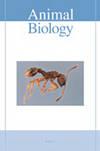Association of social group with both life-history traits and brain size in cooperatively breeding birds
IF 0.9
4区 生物学
Q2 ZOOLOGY
引用次数: 0
Abstract
Social group is associated with life-history traits and can predict brain size variation in cooperative primates and some other mammal groups, but such explicit relationships remain enigmatic in cooperatively breeding birds. Indeed, some compositions of social group in cooperative species (e.g., helper number and group size) would affect the fitness of breeders by providing alloparental care. Here, we conducted comparative tests of the relationship between the social group and both life-history traits and brain size across 197 species of cooperatively breeding birds using phylogenetically controlled comparative analyses. We did not find any correlations between helper numbers and both life-history traits and brain size. However, we found that maximum group size was positively associated with clutch size. Moreover, average group size has positive associations with body mass and relative brain size. Our findings suggest that helper numbers cannot promote variation in relative brain size, while larger groups may predict bigger brains in cooperatively breeding birds.社会群体与合作繁殖鸟类的生活史特征和脑容量的关系
社会群体与生活史特征有关,可以预测合作灵长类动物和其他一些哺乳动物群体的大脑大小变化,但这种明确的关系在合作繁殖的鸟类中仍然是谜。事实上,在合作物种中,社会群体的某些组成(如帮助者的数量和群体的大小)会通过提供异亲代照顾来影响繁殖者的适合度。本文采用系统发育控制的比较分析方法,对197种合作繁殖鸟类的社会群体与生活史特征和脑容量之间的关系进行了比较测试。我们没有发现助手数量与生活史特征和大脑大小之间有任何关联。然而,我们发现最大群体大小与卵窝大小呈正相关。此外,平均群体规模与体重和相对脑容量呈正相关。我们的研究结果表明,帮手的数量不能促进相对大脑大小的变化,而更大的群体可能预示着合作繁殖的鸟类的大脑更大。
本文章由计算机程序翻译,如有差异,请以英文原文为准。
求助全文
约1分钟内获得全文
求助全文
来源期刊

Animal Biology
生物-动物学
CiteScore
2.10
自引率
0.00%
发文量
34
审稿时长
3 months
期刊介绍:
Animal Biology publishes high quality papers and focuses on integration of the various disciplines within the broad field of zoology. These disciplines include behaviour, developmental biology, ecology, endocrinology, evolutionary biology, genomics, morphology, neurobiology, physiology, systematics and theoretical biology. Purely descriptive papers will not be considered for publication.
Animal Biology is the official journal of the Royal Dutch Zoological Society since its foundation in 1872. The journal was initially called Archives Néerlandaises de Zoologie, which was changed in 1952 to Netherlands Journal of Zoology, the current name was established in 2003.
 求助内容:
求助内容: 应助结果提醒方式:
应助结果提醒方式:


